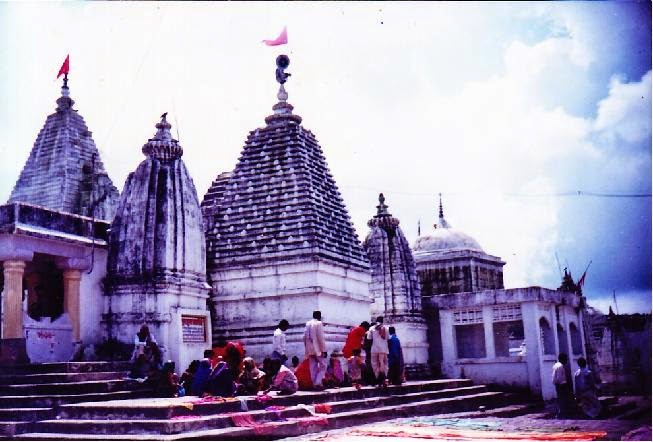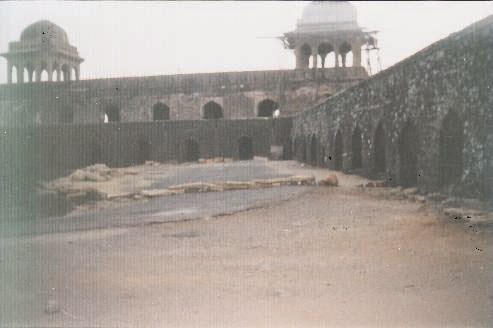On the trail of Narmada
Amarkantak:
Queen of Maikal beckons
Amarkantak
in the Shahdol district of Madhya Pradesh is renowned as the “Queen
of Maikal Hills” and forms the source of the mighty Narmada.
 |
| Narmada Mata Mandir, Amarkantak |
For
travel buffs in search of a blend of pristine natural world and
spiritual ambience that is far behind the contemporary world, a visit
to Amartkantak would be their ideal choice. Amarkantak boasts of the
confluence of three rivers of Central India- Narmada, Johila and
Sone.
It
was on one of those Navratri days during late ‘90s when we made our
way by jeep from Pendra Road, lying 42 km from Amarkantak and it was
a bone-jarring journey. Amarkantak range lies at 1,000 metres height
and we passed through the vast forest lands of Bhundokona, Jaleshwar
and Amanala.
It
was at Amarkantak that I had an experience of staying at a
dharamshala and the town experiences frequent blackouts. The
next day, we set out for Kapil Dhara, nearly 6 km from the source of
Narmada river. It is one of the highest waterfalls fed by river
Narmada and marks the union of three mighty ranges- Satpura, Vindhya
and Maikal.
At Kapil Dhara, the torrential waters of Narmada gush
down the rocky slopes from a height of 3,200 metres forming echoes.
Going downhill, we came across a serene white cascade called Doodh
Dhara.
We
wended our way to the imposing Narmada temple dedicated to Goddess
Narmada and it is here that the river originates in the Narmada Kund.
The shrine reflects an age-old charm and is thronged by a flurry of
devotees. We wandered off to Mai ki Bagiya, at a distance of
four-and-half km from the shrine complex that marks the confluence of rivers
Son and Bhadra.
The
Gond land of Jabalpur
The
largest city on the banks of Narmada and the third most highly
populated city in Madhya Pradesh is Jabalpur, once the seat of Gond
rulers that echoed with the chivalry of the Gond queen, Rani
Durgawati. If one wants to commune with nature, then the best
destination is Marble Rocks at Bhedaghat on river Narmada at a
distance of 16 km from the city.
At
Bhedaghat, nature is at its best and there’s no better way to
explore the sight than visiting on the occasion of Narmada
Mahotsav during Navratri.
 |
| Marble Rocks |
The entrance of Marble Rocks has the
statue of Lord Hanuman and as you turn around, there is the
swift-flowing river Narmada meandering along the Marble Rocks that
plunge into a smoke cascade called Dhuandhar providing vintage beauty
of nature. Visiting Bhedaghat during moonlight is a different
experience for travellers.
We
proceeded from Dhuandhar to the famed 19th century Chausat
Yogini shrine devoted to Goddess Durga.
 |
| Madan Mahal Fort |
The city also has Madan Mahal
Fort, a creation of Gond ruler, Raja Madan Shah that serves as the
best example of medieval construction. The fort has been carved on a
huge rock and served as a watchtower during the reign of Rani
Durgawati. There is Shiv Pancheshwar temple and Sharda Mata temple in
the vicinity. We negotiated a number of steps to get a glimpse of
Shiv Pancheshwar temple with the Lingam installed in the rock cave.
Omkareshwar-
A pilgrims’ world
When
I travel from Indore to Khandwa, I can never miss out the Om-shaped
Island resting on the Malwa Plateau formed at the confluence of two
rivers - Narmada and Kaveri. It’s none other than the divine pilgrim
town of Omkareshwar that has one of the 12 jyotirlingams. The holy town
injects a breath of fresh air into humdrum living and rejuvenates the
minds of pilgrims.
 |
| Omkareshwar |
The
journey from Khandwa to Omkareshwar is really enchanting with scores
of soyabean fields and cotton cultivation spreading across the blue
hills along the horizon. We were at Yatri Niwas in the holy town of
Omkareshwar that is best visited during Navratri when the sleepy
pilgrim town wakes up to a vibrant festive mood. We made our way to
the shrine of Omkar Mandhata snuggled on the foot of Mandhata Hill
and lies on a tiny island formed by the fork of Narmada.
The shrine
is across the Narmada Bridge that provides fascinating view of the
river. Mythology
puts forth that King Mandhata, the ancestor of Lord Rama had
meditated on this spot and moved by his devotion, Lord Shiva had
granted him the throne here in the form of Om-shaped Island.
The
throne of King Mandhata is still preserved in the shrine. It was at
this site that Shankracharya, the great Hindu reformer derived his
divine powers from his mentor- Govindacharya. The shrine has a
frieze of figures carved from soft stone.
Other temples to look for
are Shri Batuk Bhairav temple, Pataleshwar, Narmada and Navgraha
temples. Before departing, we trekked our way to Siddhanath temple
resting atop Mandhata Hill and built in early medieval Brahminic
style.
Medieval
world of Maheshwar
Maheshwar
on the banks of Narmada in Khargon district of Madhya Pradesh was the
brainchild of Rani Ahilyabai Holkar of Indore. Around 91 km from
Indore, Maheshwar formed the seat of Malwa culture and was best known
as Mahismati during the epic period. The road to Maheshwar from
Indore is a convenient journey than the one from Mandu.
Maheshwar
Fort is the calling card of the town that dominates the town and has
the palace or Rajwada replete with an array of shrines and
ghats on the banks of river Narmada. Sprawling over 2 km, the Rajwada
is a colossal fort with towering gateways- Ahilya Dwar and Kamani
Darwaza.
Once inside the fort, we took time to visit Rajrajeshwar
temple, a prominent religious shrine with profusely carved doorways.
The shrine honouring Lord Shiva has 11 Nanda Deepak burning
all round the year symbolizing happiness.
 |
| Vithaleshwar Temple |
At
Maheshwar, I had put up at Yatri Niwas overlooking the fort. There
are other popular shrines in the fort complex- Ahileshwar and
Vithaleshwar temple with adorned overhanging balconies. Each shrine
has a flight of steps leading to the picturesque ghats like Ahilya
Ghat, Peshwa Ghat, Vishwanath Ghat and Fanse Ghat.
Bewitching
Mandu
The
medieval town of Mandu on Malwa Plateau in Dhar district at an
altitude of 2,000 ft in western Madhya Pradesh brings back memories
of royal grandeur that stand in ruins. The town overlooks river
Narmada that flows thousand feet below.
It was in Mandu, well-known
as ‘the City of Joy” that we could sight the architectural
grandeurs of Islamic Pathan art and the town once witnessed the
blooming romance of Rani Roopmati and the poet prince, Baz Bahadur.
I
recall back a decade ago, when I was on a tour of Ujjain, I landed up
in Mandu en route Dhar and stayed at Tourist Rest House that
overlooks Jami Masjid in the hub of the town. Mandu is enclosed by 12
gateways of which Delhi Darwaza stands apart.
The architectural
landmarks are all in Central Group and the Royal Enclave or Shahi
Parisar. Some of the spectacular monuments that I came across in
Central Group are Hoshang Shah’s Tomb, the first marble edifice of
India and the one of the best examples of Afghan art that later
inspired the builders of Taj Mahal.
There is the splendid Jami Masjid
modelled on the Great Mosque of Damascus.
 |
| Ashrafi Mahal |
A
walk down the Royal Enclave brought us to Jahaz Mahal or “Ship
Palace” tucked between two lakes, Munj Talao and Kapur Talao. We
did not miss on the attractive Hindola Mahal or “Swinging Palace”
with sloping walls and ornamental façade in sandstone.
The
enchanting Nahar Jharoka or “Tiger Balcony”, built by Emperor
Jehangir and Dilwar Khan’s Mosque with Islamic Pathan architecture
are other prominent attractions in Royal Enclave.
 |
| Roopmati's Pavilion |
The special
attraction of Mandu is Roopmati Pavilion that offers a sweeping view
of 16th century Baz Bahadur Palace. Before winding up, we
visited the Sunset Point for a panoramic view of Malwa Plateau. Apart
from the bygone royal glory, one can get to interact with the tribal
settlements like Bhils, Garasias and Kalals in Mandu.


